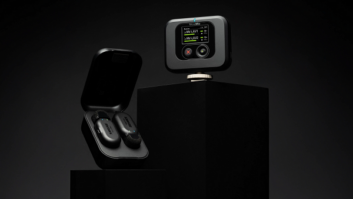Washington, D.C. – The movie and music industries and their peer-to-peer (P2P) rivals went before the U.S. Supreme Court last week to argue whether developers of P2P file-sharing software should be held liable when their users share music and video over the Internet in violation of federal copyright laws.
A decision could be issued between now and the court’s June recess.
After the court hearing, CEA president and CEO Gary Shapiro said he was optimistic that the Justices “will uphold the standards set by the Court in the landmark Betamax decision more than 20 years ago.” He said he was “thrilled” that during oral arguments, “the Justices appeared to recognize that innovation and technology are important and that technologies should not be subject to prior scrutiny by copyright owners.”
During oral arguments in the MGM vs. Grokster case, the entertainment industries argued that the primary intent of software offered by Grokster, StreamCast Networks, and other P2P software developers is to let consumers quickly and easily infringe copyrights. Donald Verrilli, attorney for MGM and other plantiffs, argued that Grokster uses copyrighted material as seed money and profits from it. The P2P companies, he said, “intentionally built a network of infringing uses and actively encouraged infringement.”
Technology companies and the Consumer Electronics Association (CEA), however, have said they fear a ruling against the P2P companies will overturn or erode the court’s own 1984 Betamax precedent. Such a decision, they contend, threatens to stifle technological innovation because inventors would fear building a product that could be used by some for illegal copying. Opponents of the content industries fear a chilling effect on the development of future digital recording A/V technologies and technologies allowing the sharing of movies and music within a home over a home network.
In the 1984 case, called Sony Corp. of America vs. Universal City Studios, the court ruled 5-4 that, even if some users did engage in infringing activities, Sony and other VCR makers were not liable for “contributory” copyright infringement because the products offered “substantial noninfringing uses.” The court, however, didn’t define “substantial.” At the time, the court also held that consumers bought VCRs mainly to time-shift TV programs for later noncommercial viewing, constituting a “fair use” of copyrighted material under copyright law.
During oral arguments last week, Grokster lawyer Richard Taranto argued his company had no way to discern legal from illegal downloads and simply gave customers a way to share files. In addition, he contended, Grokster streamlines authorized downloads and offers a low-cost tool for legitimate users. The legality of digital-era P2P software is supported by the analog-era Betamax decision, and a new standard for Grokster could stifle innovation, he argued.
Some justices, however, took exception with some of Grokster’s arguments. Justice Ruth Bader Ginsburg said she was “puzzled” by Taranto’s description of the Sony case as “clear.” That decision, she said, took 13 pages to explain how the decision would be applied. Justice David Souter called some of Grokster’s explanations “bizarre.”
For his part, Justice Stephen Breyer seemed to question whether the music industry was simply reacting to a threat to their old ways of doing business. “The monks had a fit” when Gutenberg printed the Bible, he pointed out.
The justices also questioned why the music industry hasn’t placed other potentially threatening technologies, such as Apple’s iPod, into its gunsights. Verrilli, however, claimed that Apple’s business plan is aimed at music-CD owners who want to legally transfer them to the iPod, although some incidental copyright violations possibly occur. Grokster’s entire business plan, on the other hand, is based on illegal downloads, with some incidental legal ones, he contended.
Other justices questioned where a line could be drawn to determine when the unlawful use of a technology outweighed the lawful ones. Acting U.S. Solicitor General Paul Clement, presenting the government’s opinion, said infringing uses “anywhere under 50 percent” should have “no liability under the Sony standard.”
After the hearing, the CEA’s Shapiro called the case “the most important case before the Supreme Court this year.” One the surface, he said, the case concerns peer-to-peer file sharing. “But in truth, the case is much broader. It’s about preserving America’s proud history of technological innovation and protecting the ability of consumers to access and utilize technology.”
“The Betamax principles,” he continued, “stand as the Magna Carta for the technology industry and are responsible for the explosion in innovation that has occurred in the U.S. over the past 20 years. If these principles are undermined, we may witness the end of popular and revolutionary products and technologies such as the iPod, Tivo, and even the Internet itself, and also the premature deaths of thousands of products that still only exist as a concept in the mind of young entrepreneurs.”
Striking a balance between innovation and copyright protection was also on the minds of trade-association representatives, entertainment-industry executives, and lawyers during the recent fifth annual Music Industry Forum in New York.
During the event, an executive representing on-line services contended the court could modify the Betamax decision to protect copyrights without stifling innovation. “Dual-use” technologies should be protected under Betamax, but if the “primary use” and “primary intent” of the technology is copyright infringement, technology providers should be liable for the actions of infringers, said Jonathan Potter, executive director of the Digital Media Association (DMA). Association members include AOL, RealNetworks, and Apple.
Nonetheless, Potter expressed concern that if the court’s guidance is unclear, then “if you guess wrong, you’re either the deepest pocket in the world, or you’re out iof business.”
A music industry official, however, was more optimistic. “That’s not an outcome we want,” said Victoria Bassetti, EMI Music’s senior VP of industry and government affairs. EMI wants a “balanced” and clear enough” decision so that “a general counsel can give you reasonably good advice,” she said. “It happened before, and it can happen again.”
The executive director of a P2P trade group, on the other hand, said the Betamax doctrine “should not be disturbed.” The Betamax decision lets technology developers “rely on the predictable Sony test,” allowing them to innovate without fear, said Adam Eisgrau of P2P United, whose members are five P2P companies including Grokster.
Jim DeLong, a senior fellow at the Progress and Freedom Foundation, said the court should consider business models that infringe and those that don’t. “During [times of] great technological change, property rights change,” he added. The foundation is a think tank that considers digital-technology public-policy issues.
Billing himself as a neutral third party, intellectual property lawyer Martin Elgison said he developed new standards for determining secondary liability in the digital age. They include:
·the quantity and quality of infringing and noninfringing conduct.
·the extent to which the defendant has knowledgeof the infringing conduct.
·whether the defendant has the ability to control and prevent infringing use and fails to do so.
·the extent that the revenues of the defendant result from infringing conduct.
·the extent to which the defendant intended to profit from infringing activity.
·and whether it’s in the public interest that the technology be used for noninfringing uses.
Elgison is a partner in the law firm Alston and Bird.
Whatever the court decides, however, the issue will end up before Congress, Potter noted.
Mark Rockwell is with Wireless Week.
n












